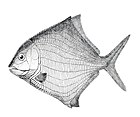
Lungfish are freshwater vertebrates belonging to the class Dipnoi. Lungfish are best known for retaining ancestral characteristics within the Osteichthyes, including the ability to breathe air, and ancestral structures within Sarcopterygii, including the presence of lobed fins with a well-developed internal skeleton. Lungfish represent the closest living relatives of the tetrapods. The mouths of lungfish typically bear tooth plates, which are used to crush hard shelled organisms.

Cladoselache is an extinct genus of shark-like chondrichthyan from the Late Devonian (Famennian) of North America. It was similar in body shape to modern lamnid sharks, but was not closely related to lamnids or to any other modern (selachian) shark. As an early chondrichthyan, it had yet to evolve traits of modern sharks such as accelerated tooth replacement, a loose jaw suspension, enameloid teeth, and possibly claspers.

Hibbertopterus is a genus of eurypterid, a group of extinct aquatic arthropods. Fossils of Hibbertopterus have been discovered in deposits ranging from the Devonian period in Belgium, Scotland and the United States to the Carboniferous period in Scotland, Ireland, the Czech Republic and South Africa. The type species, H. scouleri, was first named as a species of the significantly different Eurypterus by Samuel Hibbert in 1836. The generic name Hibbertopterus, coined more than a century later, combines his name and the Greek word πτερόν (pteron) meaning "wing".

Xenacanthida is an order or superorder of extinct shark-like chondrichthyans known from the Carboniferous to Triassic. They were native to freshwater, marginal marine and shallow marine habitats. Some xenacanths may have grown to lengths of 5 m (16 ft). Most xenacanths died out at the end of the Permian in the End-Permian Mass Extinction, with only a few forms surviving into the Triassic.
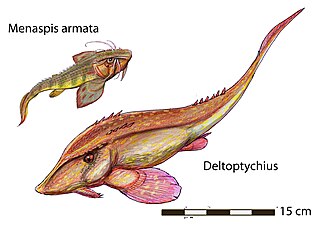
Deltoptychius is an extinct species of cartilaginous fish related to the modern chimaeras. It lived in the Carboniferous period of present-day United Kingdom. Fossils of the genus have been found in the Glencartholm Volcanic Beds Formation of the Upper Border Group in Scotland.
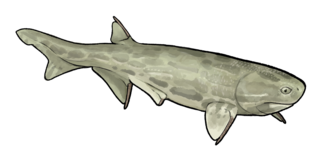
Acanthodes is an extinct genus of acanthodian fish. Species have been found in Europe, North America, and Asia, spanning the Early Carboniferous to the Early Permian, making it one of the youngest known acanthodian genera.

Perleidus is an extinct genus of ray-finned fish from the Triassic period. Fossils have been found in the Middle Triassic of Italy, Switzerland, and China. The inclusion of Early Triassic species in the genus Perleidus was questioned.

Symmoriiformes is an extinct order of stem-group holocephalians. Originally named Symmoriida by Zangerl (1981), it has subsequently been known by several other names. Lund (1986) synonymized the group with Cladodontida, while Maisey (2008) corrected the name to Symmoriiformes in order to prevent it from being mistaken for a family. The symmoriiform fossils record begins during the late Devonian. Most of them died out at the start of the Permian, but Dwykaselachus is known from the Artinskian-Kungurian of South Africa. Teeth described from the Valanginian of France and Austria indicate that members of the family Falcatidae might have survived until the Early Cretaceous; however, these teeth were also argued to be more likely neoselachian teeth.

The Palaeonisciformes, commonly known as "palaeoniscoids" are an extinct grouping of primitive ray-finned fish (Actinopterygii), spanning from the Silurian/Devonian to the Cretaceous. They are generally considered paraphyletic, but their exact relationships to living ray-finned fish are uncertain. While some and perhaps most palaeoniscoids likely belong to the stem-group of Actinopteryii, it has been suggested that some may belong to the crown group, with some of these possibly related to Cladistia and/or Chondrostei. Many palaeoniscoids share a conservative body shape and a similar arrangement of skull bones.
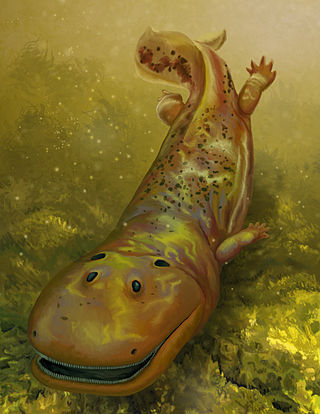
Spathicephalus is an extinct genus of stem tetrapods that lived during the middle of the Carboniferous Period. The genus includes two species: the type species S. mirus from Scotland, which is known from two mostly complete skulls and other cranial material, and the species S. pereger from Nova Scotia, which is known from a single fragment of the skull table. Based on the S. mirus material, the appearance of Spathicephalus is unlike that of any other early tetrapod, with a flattened, square-shaped skull and jaws lined with hundreds of very small chisel-like teeth. However, Spathicephalus shares several anatomical features with a family of stem tetrapods called Baphetidae, leading most paleontologists who have studied the genus to place it within a larger group called Baphetoidea, often as part of its own monotypic family Spathicephalidae. Spathicephalus is thought to have fed on aquatic invertebrates through a combination of suction feeding and filter feeding.

Neopteroplax is an extinct genus of eogyrinid embolomere closely related to European genera such as Eogyrinus and Pteroplax. Members of this genus were among the largest embolomeres in North America. Neopteroplax is primarily known from a large skull found in Ohio, although fragmentary embolomere fossils from Texas and New Mexico have also been tentatively referred to the genus. Despite its similarities to specific European embolomeres, it can be distinguished from them due to a small number of skull and jaw features, most notably a lower surangular at the upper rear portion of the lower jaw.

Acrolepis is an extinct genus of prehistoric marine bony fish that lived from the Famennian stage of the Devonian to the early Triassic epoch. Some species from the Early Triassic of Tasmania are also ascribed to Acrolepis.

Rhadinichthys is an extinct genus of prehistoric bony fish. It is known from several species that lived in the Late Devonian epoch, the Carboniferous period and the Cisuralian epoch in what is now Europe, South Africa, and North and South America. Some isolated scales from the Cisuralian of Europe were also referred to this genus.

Most bony fishes have two sets of jaws made mainly of bone. The primary oral jaws open and close the mouth, and a second set of pharyngeal jaws are positioned at the back of the throat. The oral jaws are used to capture and manipulate prey by biting and crushing. The pharyngeal jaws, so-called because they are positioned within the pharynx, are used to further process the food and move it from the mouth to the stomach.

The evolution of fish began about 530 million years ago during the Cambrian explosion. It was during this time that the early chordates developed the skull and the vertebral column, leading to the first craniates and vertebrates. The first fish lineages belong to the Agnatha, or jawless fish. Early examples include Haikouichthys. During the late Cambrian, eel-like jawless fish called the conodonts, and small mostly armoured fish known as ostracoderms, first appeared. Most jawless fish are now extinct; but the extant lampreys may approximate ancient pre-jawed fish. Lampreys belong to the Cyclostomata, which includes the extant hagfish, and this group may have split early on from other agnathans.
Blue Beach is a 2 kilometres (1.2 mi) stretch of cliff-bordered coastline at Avonport, Nova Scotia near the mouth of the along the Avon River in the southern bight of Minas Basin, Kings County, Nova Scotia, Canada. It is best known as a globally significant fossil location for Lagerstätte of the Tournaisian Stage period.
Cladodus is an extinct genus of cartilaginous fishes in the family Ctenacanthidae. As the name implies, they are a type of cladodont, primitive sharks with teeth designed to snag fish and swallow them whole, instead of sawing off chunks to swallow.
Ozarcus is an extinct genus of symmoriiform from the Carboniferous period of Arkansas. The type species, Ozarcus mapesae, was named in 2014 based on cartilaginous skulls from the Serpukhovian-age Fayetteville Formation. The genus is named after the Ozark Mountains while the species was named after its discoverer, G. K. Mapes.
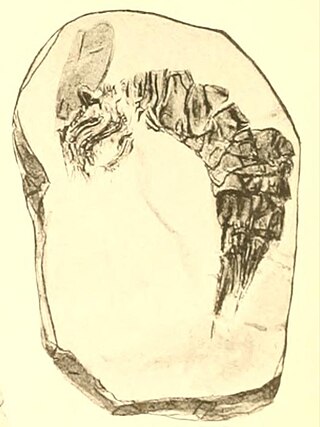
Bairdops is an extinct genus of mantis shrimp that lived during the Early Carboniferous period in what is now Scotland and the United States. Two named species are currently assigned to it. The type species, B. elegans, has been collected from several Dinantian-aged localities in Scotland, and was first described in 1908 by British geologist Ben Peach as a species of Perimecturus. The generic name was coined decades later in 1979 by American paleontologist Frederick Schram, and honors William Baird. A later species, B. beargulchensis, was named in 1978 after the Serpukhovian-aged Bear Gulch Limestone of Montana where it was discovered. The two species were originally deemed close relatives based on their physical similarities, but several cladistic analyses published since 1998 have suggested the genus may be polyphyletic.

Perimecturus is an extinct genus of mantis shrimp that lived during the Early Carboniferous period in what is now Scotland and the United States. The first known specimens were collected near the River Esk in Glencartholm, Scotland, and the genus was named in 1908 by Ben Peach, making it the second genus of Paleozoic mantis shrimp to be described. While many species have been classified in the genus since then, taxonomic revisions in the late 20th and 21st centuries have reassigned most of these to different genera, leaving two named species currently assigned to this genus. The type species, P. parki, was first named in 1882 as a species of Anthrapalaemon and is known from the Viséan-aged Glencartholm Volcanic Beds of Scotland. Fossils of a later species, P. rapax, have been found in the Bear Gulch Limestone of Montana and were first described by Frederick Schram.























